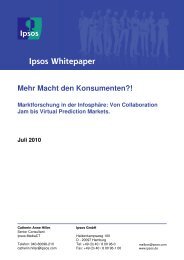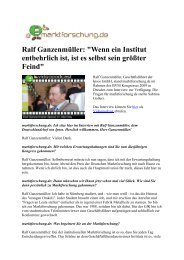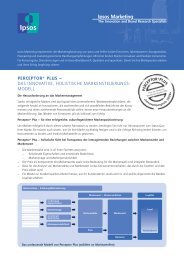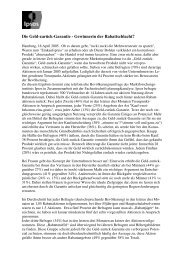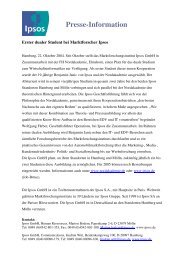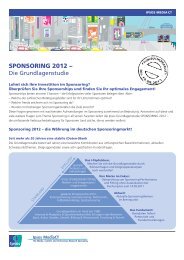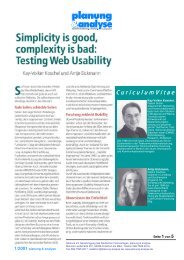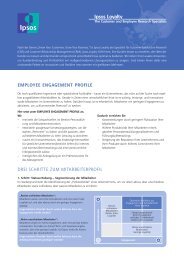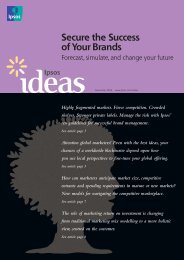Corporate Reputation:
Corporate Reputation:
Corporate Reputation:
You also want an ePaper? Increase the reach of your titles
YUMPU automatically turns print PDFs into web optimized ePapers that Google loves.
<strong>Corporate</strong> <strong>Reputation</strong>:<br />
Connecting Fantasies with Reality<br />
March 2006 www.ipsos.com/ideas<br />
How can corporations increase the concordance between<br />
their projected image and the real one, thus strengthening the<br />
corporation’s credibility at a time when brands suffer from<br />
a legitimacy crisis? Ipsos measures corporations’ reputation<br />
and image among their stakeholders: shareholders,<br />
consumer-clients, media, and employees.<br />
Building Stakeholder Relations See article page 3<br />
by Stewart Lewis<br />
What You Do Speaks So Loudly that I (Sometimes)<br />
Cannot Hear What You Say See article page 4<br />
by Edouard Lecerf<br />
The Resiliency Concept See article page 5<br />
by Darrell Bricker<br />
<strong>Corporate</strong> <strong>Reputation</strong> with Consumer-Clients See article page 7<br />
by Nando Pagnoncelli<br />
Employees-Corporations:<br />
Towards a Transactional Relationship? See article page 10<br />
by Antoine Solom<br />
How Institutional Investors Assess Companies See article page 12<br />
by Roger Stubbs
2 Ipsos Ideas<br />
When will Mothering Happen? By Jean-Marc Lech<br />
A corporation is no different<br />
from a body; that is, it is a set<br />
of interdependent mechanisms.<br />
A healthy corporate body has<br />
rich and decisive shareholders,<br />
efficient and motivated<br />
employees, and satisfied and<br />
loyal customers, but unfortunately<br />
for businesses, this<br />
healthy body only produces<br />
benchmarks – the best of<br />
everything, but also the most<br />
inaccessible. Sad but true.<br />
We have a mental representation<br />
of business: shareholder<br />
groups, employees, and customers.This<br />
image develops,<br />
and can sometimes build itself<br />
up suddenly via a dialectic<br />
connecting fantasy and reality.<br />
And this image continually<br />
(re)creates itself, and strays in<br />
its recreation. And, if there are<br />
surprises, the balance in the<br />
corporate body becomes<br />
unstable and incomplete.<br />
The global financial situation,<br />
the local political and social<br />
climates, and the unfaithful<br />
customers (who are neither<br />
disappointed nor angry) make<br />
benchmarking as imprecise as<br />
long-term weather forecasting.<br />
The uncertain management<br />
of corporate meteorology<br />
makes it necessary to carry out<br />
precise analyses for each part<br />
of the body, as if we could see<br />
further away by looking more<br />
closely.Trying to see the future<br />
by looking close to home is<br />
the stuff of mythology.<br />
They are three myths: the<br />
contract, the father, and mothering.The<br />
four-way contract –<br />
between the business, the shareholders,<br />
the employees, and<br />
the customers – is unlikely,<br />
because the adjustment variables<br />
brought on by crisis adulterate<br />
it.The paternal dogma<br />
– despite the father figure, and<br />
despite the name of the Father<br />
so dear to the Freud-Lacan<br />
clique – is outdated, because<br />
it has not anticipated the<br />
challenge to its authority.<br />
Therefore, since nothing is<br />
immutable, the focus will be<br />
on a new co-management<br />
between the business and<br />
its prerogatives.We call it<br />
mothering.The filial trinity<br />
of the business is co-produced<br />
with risks, even when the<br />
father and mother are<br />
healthy… when the triplets<br />
are born.<br />
About Ipsos Ideas<br />
Ipsos Ideas is published by Ipsos,<br />
a leading global survey-based market<br />
research company. Current and past<br />
issues of Ipsos Ideas are available at<br />
www.ipsos.com/ideas.<br />
To receive a free email subscription,<br />
to send us your comments or questions,<br />
or to unsubscribe to the newsletter,<br />
please email charlotte.vigne@ipsos.com<br />
or write us at:<br />
Ipsos Ideas<br />
Communications Department<br />
35 rue du Val de Marne<br />
75013 Paris cedex 13, France<br />
Tel: +33 1 41 98 90 00<br />
Fax: +33 1 41 98 90 50<br />
Publisher<br />
Jean-Marc Lech<br />
Editorial Board Members<br />
Jean-Marc Lech • Stewart Lewis<br />
Edouard Lecerf • Darrell Bricker<br />
Nando Pagnoncelli • Antoine Solom<br />
Roger Stubbs<br />
Editorial Team<br />
Dan Maceluch • Catherine Roussiès<br />
Charlotte Vigne • Erin Williams<br />
Marketing<br />
Elen Alexov • Darcy Ulmer<br />
Production<br />
Roland Clifford<br />
© 2006, Ipsos. All rights reserved.<br />
Past publications:<br />
July 2005:<br />
“Loyalty: Myths and Realities about Desire”<br />
January 2005:<br />
“Krisis: The New Qualitative Approach<br />
from Ipsos”<br />
November 2004:<br />
“Secure the Success of Your Brands”<br />
October 2004:<br />
“The Faces of Political Seduction”<br />
February 2004:<br />
“The New Era of Customer Relationships”<br />
September 2003:<br />
“Opinions of the War, and the War<br />
of Opinions”<br />
May 2003:<br />
“Advertising: Money Down the Drain?”<br />
Jean-Marc Lech is Co-President of Ipsos and has worked alongside Didier Truchot since 1982. A specialist in the public opinion field, he<br />
started his career in 1970 with IFOP (Institut Français d’Opinion Publique), of which he was made Chairman and Managing Director in 1980.<br />
He has published a number of works relating to French society and politics, the most recent of which was entitled Une société sans mercis (2006).<br />
Contact: jean-marc.lech@ipsos.com.
Building Stakeholder Relations By Stewart Lewis<br />
<strong>Reputation</strong> is like the weather – it exists, irrespective of whether we measure it.<br />
It dictates what activities and goals are feasible, and how we should clothe and<br />
present ourselves in order to be credible and healthy. It is sensible to check the<br />
weather before we venture out, and even more useful if we know how it is<br />
changing. So it is with reputation.The key difference between the weather and<br />
reputation is that while we cannot control the weather, we can manage our<br />
reputation. And there is a clear case for managing it.<br />
For the private sector, reputation is a<br />
business asset with bottom-line implications:<br />
the trust (or distrust) of stakeholders makes<br />
business easier (or more difficult), more<br />
satisfying (or more frustrating), and more<br />
profitable (or more costly). For public<br />
sector organisations, reputation is a critical<br />
determinant of credibility, acceptance,<br />
and success.<br />
Our aim is straightforward: to help clients<br />
build stronger relationships with the people<br />
who matter to them.That means providing<br />
practical and well-informed guidance; for<br />
instance, identifying the key drivers of reputation,<br />
the credible and powerful messages<br />
for each individual client, and the points in<br />
the chain of influence where they can most<br />
effectively intervene.<br />
Core factors<br />
To help us think about the mechanics of<br />
reputation, we can start with core factors<br />
within a company’s control: its behaviour,<br />
values, strategy, and communications.<br />
All these factors are pivotal to reputation –<br />
and there must be alignment and consistency<br />
between them – but behaviour is the<br />
rightful starting point. However slick a<br />
company’s communications, it will sustain<br />
a strong reputation only if its actions stand<br />
up to scrutiny. Having said that, communications<br />
are vital. Many of the key factors<br />
by which stakeholders now judge companies<br />
– such as corporate responsibility – require<br />
company investment to communicate.<br />
It’s a balance to strike: Advertising is worth<br />
doing when you’ve done something<br />
worth advertising. These core reputation<br />
factors do not exist in isolation, but are<br />
surrounded by a mantle of issues.<br />
Issues<br />
Issues are more akin to a swirling cloud,<br />
constantly emerging and disappearing<br />
again, only to reappear in modified form.<br />
Twenty years ago, an oil company could<br />
establish a leading reputation and trust on<br />
the basis of the message “We’re big and<br />
successful”; such a message would win few<br />
hearts and minds in 2006.The past decade<br />
has seen dramatic growth in interest in<br />
the company behind the brand, demanding<br />
fundamental shifts in strategy on the part<br />
of organisations such as Unilever and<br />
Procter & Gamble.<br />
Stakeholders<br />
Ipsos Ideas<br />
Surrounding the issues and the organisation<br />
revolve its key stakeholders: customers,<br />
investors, legislators, business partners, media,<br />
lobby groups, employees, and so on.<br />
The interests and expectations of different<br />
audiences are sometimes in conflict,<br />
requiring the organisation to strike a<br />
balance in priorities and communication.<br />
More frequently, they are in unison, as<br />
in the priority attached to integrity and<br />
honesty, particularly following the collapse<br />
of Enron and other corporate scandals.<br />
The orbits of different audiences often<br />
intersect – a point not sufficiently recognised<br />
in much of the debate (and research) on<br />
reputation. Analysis and insight into these<br />
interactions and the chain of influence<br />
they create add depth and practical value<br />
to our advice.<br />
Tailored advice is central to our approach.<br />
There are some widely-recognised trends in<br />
reputation, such as the growing expectations<br />
of corporate responsibility, but how does<br />
this translate into specific opportunities and<br />
Continued…<br />
3
4 Ipsos Ideas<br />
Building Stakeholder Relations<br />
threats for a particular company? A number<br />
of factors determine the answer, including<br />
the issues associated with the sector(s) in<br />
which a company operates, the positioning<br />
of competitors, and, critically, the company’s<br />
own reputation strength and character –<br />
its corporate resiliency, as described in the<br />
article following by Darrell Bricker.<br />
It is rare that reputation can usefully be<br />
condensed into a single indicator. Norms<br />
and perspective are helpful though.The<br />
same absolute rating on two dimensions<br />
can represent outstanding performance on<br />
one but disastrous weakness on another;<br />
a strong level of advocacy in one sector<br />
can be uncompetitive in another.<br />
<strong>Reputation</strong> research can – and should – do<br />
much more than deliver figures. It should<br />
help your organisation engage the goodwill<br />
of stakeholder groups by answering these<br />
kinds of questions:<br />
• How soft or resilient is the equity in<br />
your company’s reputation?<br />
• What messages will enhance<br />
stakeholders’commitment to you?<br />
• What are the opportunities and barriers<br />
for getting your messages across?<br />
<strong>Reputation</strong> has never been more important<br />
to companies, and never more vulnerable.<br />
Many stakeholder audiences feel that companies<br />
are not meeting their expectations;<br />
how can your company convince stakeholders<br />
that it is the exception? How can<br />
it achieve the status of one of our clients,<br />
about which a senior government respondent<br />
said,“I am filled with admiration for<br />
[the company] and will have no word said<br />
against it in my presence”? Research can<br />
help, if it can reach the right people,<br />
ask the right questions, and interpret the<br />
findings with real knowledge and insight.<br />
That is the heart of our approach.<br />
Stewart Lewis joined MORI in 1976, after<br />
graduating in modern languages from Cambridge<br />
University. He now heads the Ipsos MORI <strong>Reputation</strong><br />
Centre, serving the needs of clients across a range<br />
of sectors. As well as directing work for clients,<br />
Stewart is a frequent speaker and writer on the<br />
subject of corporate communications. He is a full<br />
member of ESOMAR (The European Society for<br />
Opinion and Marketing Research), a committee<br />
member of the International <strong>Corporate</strong> Identity<br />
Group, and Chairman<br />
of the International<br />
Visual Communication<br />
Association.<br />
He can be reached at<br />
stewart.lewis@<br />
ipsos-mori.com.<br />
What You Do Speaks So Loudly That<br />
I (Sometimes) Cannot Hear What You Say<br />
By Edouard Lecerf<br />
Politicians have always known that<br />
reputation counts. They’ve even<br />
borrowed a few techniques from<br />
marketing, such as quantitative and<br />
qualitative studies. If companies<br />
took the time to grasp the<br />
importance of this intangible asset,<br />
here too, the gap would be filled.<br />
Leading organizations monitor or –<br />
even better – anticipate shifts in public<br />
opinion. Today, executives worry<br />
just as much about the citizen as<br />
they do about the consumer, and<br />
just as much about the influencers<br />
as they do about the distributor.<br />
They have understood that the<br />
organization, by the simple affirmation<br />
of its existence, is constantly<br />
“speaking.” And that it is heard.<br />
An organization’s personality is also<br />
subject to the laws of the court<br />
of opinion, which is chaired by the<br />
general public, the opinion leaders,<br />
and those that relay it. In the eyes of<br />
these audiences, the organization<br />
will build its image and reputation<br />
through elements that it masters<br />
(its products, its commercial and<br />
social policies, and its communications)<br />
or through more exogenous<br />
elements (the competition, the<br />
market, the sector image, and the<br />
social and economic climate). This<br />
is why it is worthwhile to monitor<br />
and understand each of these<br />
audiences, and why it is just as<br />
crucial to understand the opinion<br />
climate when reviewing an<br />
organization’s image.<br />
What you do speaks so loudly that<br />
I cannot hear what you say<br />
This telling Ralph Waldo Emerson<br />
quote summarizes in a way what<br />
Ipsos Public Affairs is proposing to<br />
organizations: to help them understand<br />
what they are so that they can<br />
say it even better. We have built<br />
our expertise in all sectors where<br />
reputation and image are fundamental<br />
elements. Our analytical tools<br />
bring the structure and the weight<br />
of each dimension in shaping the<br />
overall image up to date. The lessons<br />
learned from monitoring many<br />
social, financial, environmental, and<br />
leadership crises put their seriousness<br />
into perspective and help<br />
anticipate and respond to such<br />
crises in the future.<br />
The organization’s image, the<br />
executives’ image, readability, the<br />
benefits expected from a strategy,<br />
the preparation and monitoring<br />
of the impact of a communication,<br />
a sponsorship or an action, and the<br />
trends in national and international<br />
opinion are but a few of the<br />
techniques used to assess and<br />
analyse a company’s reputation.<br />
Edouard Lecerf has been Managing Director of Ipsos Public Affairs in France since 2000,<br />
after three years as Deputy Managing Director within the company. A graduate of the<br />
French Political School (IEP), he started his career as a journalist<br />
before joining the market research industry. In 1987, with IFOP, he<br />
was responsible of political and international public opinion polls<br />
and studies. From 1990–1995, he was head of the Opinion-Media<br />
department of the French Government Information Service, before<br />
being appointed Deputy Managing Director of Louis Harris (France).<br />
He can be reached at edouard.lecerf@ipsos.com.
Ipsos Ideas<br />
re . sili . ency noun 1: an occurrence<br />
of rebounding or springing back<br />
2: the physical property of a<br />
material that can return to its<br />
original shape or position after<br />
deformation that does not exceed<br />
its elastic limit<br />
The Resiliency Concept By Darrell Bricker<br />
It’s All About Trustmarks<br />
The future will be dominated by competition for public trust. People are<br />
increasingly turning to “trustmarks” to sort through the cluttered information<br />
economy marketplace. For organizations interacting with the public, trustmarks<br />
will supersede the trademarks of old. A trustmark goes well beyond a good brand<br />
name; today, people are seeking guidance of a higher order.We want to be able<br />
to judge quickly if the information coming our way – about products to buy,<br />
decisions to make, causes to support – is authoritative, credible, and reliable.<br />
We aren’t seeking a signal about the quality of the product as much as the<br />
trustworthiness of the producer, whether it is a corporation, a charity,<br />
or a political leader.<br />
As the default position tends to be set on<br />
scepticism rather than trust, the trustmark<br />
holder possesses a rare and valuable asset.<br />
Leaders must excel beyond the traditional<br />
management skills of finance, strategy,<br />
and marketing to master the political skills<br />
necessary to forge trusting relationships<br />
with the new knowledge consumer/citizen,<br />
as trustmark stewardship will become one<br />
of the top tasks of modern CEOs.<br />
The marriage of the most highly educated<br />
generation in history and the Internet<br />
places phenomenal power in the hands of<br />
a newly enfranchised class of knowledgeable<br />
citizens and consumers. Information has<br />
been democratized, giving rise to heretofore<br />
unprecedented demands for choice.The<br />
“no alternative” mentality no longer suffices;<br />
we will create our own alternatives if the<br />
official offerings don’t satisfy.<br />
Indeed, the lode of information now available<br />
to individuals and groups is giving<br />
rise to a revolutionary power shift from<br />
producers to consumers. Producers are under<br />
pressure like never before to deliver results<br />
and be accountable for performance.<br />
Combine this heightened consumer assertiveness<br />
with a diminution of brand loyalty<br />
and the potential exists for businesses –<br />
despite having taken decades to build –<br />
Continued…<br />
5
6 Ipsos Ideas<br />
The Resiliency Concept<br />
to be destroyed in the blink of a cursor.<br />
The challenges posed by the new knowledge<br />
consumer/citizen are obvious, but so are<br />
the advantages for those who can relate to<br />
a more informed and wilful population.<br />
When we paint this picture for our clients,<br />
the obvious question comes back:<br />
“Okay smart guy, what do I do about it?”<br />
Until recently, our answers were less than<br />
satisfying.That’s because the canon of<br />
corporate reputation research we could<br />
reference was weak. As much as clients<br />
desire to understand and effectively manage<br />
their organization’s reputation, they also<br />
crave a reliable measurement tool that shows<br />
the value of what they do for their employers.<br />
In this regard, public affairs professionals<br />
are at a major disadvantage at the boardroom<br />
table. Sales professionals can reference<br />
sales data, operations managers can reference<br />
supply chain statistics, and finance professionals<br />
have their financial<br />
reports: what does a public<br />
affairs professional have<br />
to show for their efforts –<br />
press clippings?<br />
The ideal tool for a corporate<br />
reputation measurement<br />
must be able to help manage<br />
a company’s reputation and be<br />
able to stand up to scrutiny<br />
from senior corporate executives.<br />
Like so many things,<br />
the best solutions to a<br />
complicated problem emerge<br />
from combining lessons across disciplines.<br />
In this instance, it’s political polling, issues<br />
management, brand equity, and loyalty.What<br />
has emerged from our ongoing innovation<br />
activities is the core concept of our<br />
new proprietary corporate reputation<br />
tool: resiliency.<br />
Resiliency<br />
Measuring corporate reputation is more<br />
than assessing favourability and ratings<br />
on key attributes. Ipsos Public Affairs has<br />
developed a new approach that enables<br />
clients to understand their corporate equity<br />
and its resiliency: how easily their corporate<br />
equity can be carved away or enhanced<br />
by media coverage and communications.<br />
The development of the resiliency model<br />
shows that it is difficult for a company to<br />
<strong>Reputation</strong>:<br />
You only know<br />
what is worth<br />
when it lies<br />
in tatters<br />
– Alison Maitland<br />
in The Financial Times,<br />
March 31, 2003.<br />
Table 1 After a After a<br />
Start Negative Positive<br />
Elements Point Message Difference Message Difference<br />
Son/daughter work for 60.5 48.9 –11.6 61.4 0.9<br />
Recommend 60.3 49.3 –11 60.7 0.4<br />
Loyal 48.8 43.4 –5.4 49.1 0.3<br />
Trust 59.4 47.3 –12.1 56.4 –3<br />
Comfortable investing in 51.7 41.1 –10.6 51.3 –0.4<br />
compensate for negative press by communicating<br />
a positive story (ask any politician<br />
who has been the victim of a negative ad<br />
campaign). Our research indicates that a<br />
negative message or incident, such as a strike<br />
by workers, can have a significant impact<br />
on overall reputation, whereas a positive<br />
message, such as an award for environmental<br />
stewardship, can have very little impact.<br />
Negative messages associated with financial<br />
reporting and those associated<br />
with the workplace were<br />
shown to detract from the<br />
overall reputation of a company<br />
more than messages on<br />
customer service or product<br />
quality. However, none of<br />
the positive messages tested<br />
had a significant impact on<br />
corporate reputation.<br />
There are five key business<br />
measures that are standard<br />
to the resiliency model:<br />
trust, loyalty, likelihood to recommend<br />
the company, workplace, and investing.<br />
Various categories of communications have<br />
been tested, including customer service,<br />
product quality, citizenship, and financial<br />
reporting.<br />
A summary of the impact of positive<br />
and negative messages on the five business<br />
elements is shown in Table 1.<br />
The model also enables us to establish norms<br />
for overall opinion, on the five business<br />
elements, and on the expected shifts<br />
in opinion. Further, we can determine the<br />
messages that will be most effective in<br />
enhancing reputation and the messages that<br />
would be most detrimental to reputation.<br />
We can also segment the marketplace to<br />
determine the profile of consumers most<br />
affected by key messages. Standard penalty-<br />
reward analysis and competitive mapping<br />
can also be conducted under the model.<br />
One of the key findings from our research<br />
so far is that likelihood of recommending<br />
the company to family and friends was the<br />
most significant driver of overall reputation<br />
of the five business elements that were<br />
included in the testing, followed by trust<br />
in the company. Of lesser significance<br />
were “happy if my son or daughter worked<br />
there,” loyalty and investment confidence<br />
(i.e.,“I would be comfortable investing in”).<br />
We also found that not all customers care.<br />
About one in five respondents are significantly<br />
affected by negative messages – their<br />
opinion can shift by more than twenty<br />
points. Comparatively, less than ten percent<br />
are similarly affected by positive messages.<br />
Our research also shows that companies<br />
need to concentrate on building a<br />
reservoir of goodwill through consistently<br />
strong performance and a history<br />
of positive product and customer<br />
experiences. While philanthropic activities<br />
can contribute another layer, they are rarely<br />
sufficient to protect against an attack on<br />
one’s reputation.The bottom line is that how<br />
an organization handles bad news is the<br />
most important element in determining its<br />
overall corporate reputation. It’s in times<br />
of crisis that trustmarks are made or lost.<br />
Author’s note:This article borrows heavily on the<br />
work of Natalie Lacey of Ipsos Public Affairs, who<br />
developed the resiliency model.Additional contributors<br />
included John Wright,Sandra Guiry, and John Hallward.<br />
Darrell Bricker is President and COO of Ipsos Public Affairs in North America. He joined the company in 1989 after holding increasingly<br />
senior research positions, including director of public opinion research in the Office of the Prime Minister of Canada. Darrell is often<br />
called on by the media to comment on the major issues of the day, particularly federal and international politics and election campaigns.<br />
He is the author of several books, including Searching for Certainty (Doubleday Canada). Contact: darrell.bricker@ipsos-na.com.
<strong>Corporate</strong> <strong>Reputation</strong> with Consumer-Clients By Nando Pagnoncelli<br />
The Importance of Media Segmentation and Socio-Semiotic Approach and Evaluation Areas<br />
Ipsos Ideas<br />
The importance of a corporation’s reputation and image among consumers stems from<br />
the awareness that buying behaviour is based on a set of circumstances, values, and<br />
loyalties, as well as technical, distribution, and price characteristics. A consuming act has<br />
a meaning that can be broken down into what the product or service communicates<br />
to the consumer (the message) and how it is communicated (the medium).<br />
Continued…<br />
7
8 Ipsos Ideas<br />
<strong>Corporate</strong> <strong>Reputation</strong> with Consumer-Clients<br />
Familiarity and Favourability (Investors)<br />
High level of<br />
information from TV<br />
High level of<br />
entertainment from TV<br />
Not<br />
Informed<br />
Since the reputation is both the message<br />
and medium, it gains additional importance<br />
in the present context of uncertainty. <strong>Corporate</strong><br />
reputation coexists with satisfaction,<br />
loyalty, and equity strategies, but has its own<br />
unique characteristics: it is built up over<br />
long periods, it can change very quickly,<br />
it involves a judgement of the company as<br />
“corporate citizen” (apart from judgements<br />
made from the consuming experience), and<br />
it is tied to individuals’ levels of awareness.<br />
In analysing corporate reputation it is<br />
important to define<br />
1. who the clients are and how to<br />
sample correctly;<br />
2. what the communicative meta-channels<br />
of the main actors are (history, news,<br />
products, sponsorships, advertisements,<br />
logos, etc.); and<br />
3. what the company reputation is within<br />
its sector. (Key factors differentiating<br />
them from their competition and general<br />
perception of other businesses present<br />
in the sector).<br />
Consumer-Client Groups<br />
The definition of client must be as broad<br />
as possible, and may include present and<br />
Informed<br />
Uninformed<br />
Well<br />
Informed<br />
potential clients of a company and of its<br />
competitors. <strong>Corporate</strong> reputation studies<br />
require a broader approach than a customer<br />
satisfaction study insomuch as the objective<br />
is to study the mood concerning a given<br />
company: if study designs are too limited,<br />
results would offer a partial and decontextualised<br />
vision. It is fundamental to identify<br />
a suitable customer classification system<br />
designed around the needs of the reputation<br />
study, since often some clusters have anticipatory<br />
capacities regarding changes in<br />
perception, while others have mixed needs.<br />
Media Segmentation<br />
Apart from the corporate classifications<br />
and those based on use, loyalty, and on<br />
socio-demographic/cultural data, it is very<br />
useful to create a classification based on<br />
attitude to media.This classification studies<br />
the media the subject is exposed to (which<br />
ones and for how long) and the quality<br />
of the use (how).<br />
This classification emerges from the fact<br />
that not all media is the same, and often<br />
television information tends to level out and<br />
standardise perceptions. Media segmentation<br />
makes it possible to evaluate various levels<br />
and different qualities of information that<br />
Pay attention to<br />
information sources<br />
outside TV<br />
often relate to higher critical thought.<br />
Media segmentation offers the best expression<br />
of a company’s corporate reputation<br />
potential because it compares the evolution<br />
of clusters of consumer-clients over time.<br />
In the Italian market, we identified four<br />
large clusters (based on 5,000 interviews):<br />
The Well Informed cluster is made up of<br />
people sensitive to information transmitted<br />
by several sources: big readers of the<br />
business pages and Internet users for information<br />
purposes, they love to investigate;<br />
they shun entertainment television.They<br />
are the most sensitive to minor news items<br />
and are the most capable of forming a<br />
critical opinion.<br />
The Informed have a good level of information,<br />
often due to investigative television<br />
programmes.To increase their information<br />
level, at times they consult other media, such<br />
as newspapers, the radio, and the Internet.<br />
Their attitude towards information is open,<br />
although often passive, and not always<br />
inclined to in-depth study. Highly informed<br />
of more well-known events, they are not<br />
always able to form a critical opinion.<br />
The Misinformed/Less Informed are people<br />
who relate particularly to entertainment
<strong>Corporate</strong> <strong>Reputation</strong> with Consumer-Clients<br />
television.They often take in superficial<br />
information and, although they watch the<br />
news and sporadically use other media,<br />
to a large extent, they shun information and<br />
investigation, they are easily conditioned<br />
by advertising and communication, and<br />
they tend to have prejudices and absorb<br />
news uncritically.<br />
The Not Informed have average television<br />
use, but they watch entertainment television<br />
almost exclusively and hardly ever use other<br />
media for information.They frequently<br />
express low critical capacity and an often<br />
passive and fatalistic attitude.<br />
The Socio-Semiotic Approach<br />
Apart from defining the customers, it is<br />
necessary to define reputation and how it<br />
is transmitted: a motivational analysis is<br />
essential for evaluating the reputation of<br />
the sector and the company and for identifying<br />
important values, communiqués,<br />
and communication channels. In this area,<br />
it is often very useful to study the way<br />
the company presents itself to the world<br />
around it, which could be offered by a<br />
socio-semiotic approach.<br />
This is a semiotics-based approach, so it<br />
does not consult consumers – whose vision<br />
is limited by their own experience. Rather,<br />
it directly and profoundly addresses all the<br />
company issues as developed at different<br />
levels (media, internal, interpersonal, etc.)<br />
and circulating publicly as continuous<br />
communications flow. Issues are analysed as<br />
elements of the company’s communications<br />
system, understood as resulting from all the<br />
lesser or more explicit, public, and conscious<br />
communicative actions, including advertising<br />
and PR, internal communication, logistics<br />
and partnerships, warranties for goods and<br />
services, the public image of top management,<br />
and the company organisation, which<br />
altogether form the phenomenological<br />
manifestation of the actual company.<br />
Lastly, it is important to identify the<br />
decisive factors and the reputation of the<br />
category or sector – a clear representation<br />
of the context – and to define the relative<br />
position of the company.<br />
Still, the definition of reputation – which<br />
must be adapted to each individual case –<br />
can be organised into a few large areas:<br />
Different behaviour of the targets about corporate image statements<br />
• The direct and indirect experience of<br />
consumption or use, both referring<br />
to product and to the company’s capacity<br />
to connect with consumers.<br />
• The perception of the company as a<br />
corporate citizen; in other words,<br />
the perception of its relationship with<br />
employees (would recommend working<br />
for, perceived discriminations), attention<br />
to social issues and the environment,<br />
its respect for laws and ethical behaviour<br />
in the way it operates in the market (as<br />
well as formal compliance with the law),<br />
its independence, etc.<br />
• The future prospects concerning the<br />
market and the capacity of the company<br />
to plan for the future (perception of<br />
and sharing of the corporate vision,<br />
innovativeness, strategies, stock market<br />
trends, etc.).<br />
In brief, the growing role of corporate<br />
reputability requires in-depth reflection on<br />
three aspects: who the reference public<br />
Ipsos Ideas<br />
is and how its diversity can be analysed<br />
for operative representation, which metachannels<br />
the company uses to talk about<br />
itself, and the company’s reputation within<br />
a given market.<br />
For more on consumer-clients, see “Myth Today” in<br />
Mythology by Roland Barthes, L’era del cliente by<br />
Antonio G. Busacca, “Marketing e comunicazione dopo<br />
l’11 settembre” AA.VV., in Micro&Macro Marketing,<br />
and Brands Laid Bare: Using Market Research for<br />
Evidence-Based Brand Management by Kevin Ford.<br />
For background on the socio-semiotic approach, see<br />
Semiotics, Marketing and Communication: Beneath the<br />
Signs, the Strategies by Jean-Marie Floch, and Semiotica<br />
al marketing, Roberto Grandi, editor.<br />
The article includes the contribution from Sara Taddei,<br />
a socio-semiotic researcher with Ipsos Italy, with an<br />
academic background in socio-semiotic from Bologna<br />
University, where she studied under Umberto Eco,<br />
Ugo Volli, and Caterina Schiavon.<br />
Nando Pagnoncelli is CEO of Ipsos Italy. He has over fifteen years of experience in research analysis and general management, and has<br />
held senior positions including Managing Director of the Sofres Group in Italy. Nando is the Vice President of Assirm (Italy’s market research<br />
institute), serves on the science board of several leading Italian associations, and has published political essays. He also teaches at Università<br />
Cattolica in Milan. Contact: nando.pagnoncelli@ipsos.it.<br />
9
10 Ipsos Ideas<br />
Employees and Companies:Towards a Transactional Relationship<br />
By Antoine Solom<br />
For many years now,<br />
the relationship between<br />
the employee and the<br />
company has been<br />
touted as one of the key<br />
pillars of a sustainable<br />
economy. Is this not<br />
somewhat paradoxical,<br />
now that the traditional<br />
model of the employee<br />
pursuing a life-long<br />
career within the company<br />
is a thing of the<br />
past? In an increasingly<br />
uncertain economic<br />
environment, this tacit contract has indeed taken a beating. At the same time,<br />
the new employee generation is also found to be more individualistic and less<br />
predictable. Some feel they are less involved than their predecessors, almost distant<br />
toward the company and its management, as they place greater importance on<br />
their personal lives than on their professional careers – let us note that the HR<br />
discourse readily substitutes “professional career” for “professional evolution,”<br />
a term which implies a career path that is less bottom-up and more horizontal.<br />
This shift is not simply semantic, because<br />
the extension of professional life, the<br />
erosion of classic hierarchical structures,<br />
and the generalization of matrix<br />
organizations accelerate these trends.<br />
It seems that the more the employer –<br />
employee relationship is strained,<br />
the more the company must assert the<br />
importance of its human capital.<br />
The increasing number of employee opinion<br />
research studies conducted by companies<br />
is a good example of this.The questions<br />
asked are also a good example; hence the<br />
recurring questions on the importance<br />
of the sacrifices that employees are ready<br />
to make in their personal lives in order to<br />
advance their professional lives clearly<br />
reflect a state of mind characteristic of the<br />
80s and 90s.Today, we try to measure the<br />
degree of employee commitment rather than<br />
satisfaction, motivation, or involvement.<br />
We will not dwell on the haziness that<br />
surrounds the use of many of these notions<br />
1 This study was conducted between September 6 and October 11, 2005, on a sample representative of European employees aged 18 and over<br />
(excluding tradespeople, shopkeepers, professionals, and farmers/operators.) In total, 10,288 individuals were surveyed.<br />
and the deviations we end up with more and<br />
more often: can employee commitment<br />
be summed up as a performance indicator in<br />
the same way as stock-market performance?<br />
If the authority–security equation that<br />
has long governed the company–employee<br />
relationship has done its time, what has<br />
replaced it? A recent study conducted in<br />
Europe by Ipsos for Accor Services on<br />
employees’attitudes toward work and toward<br />
their employer provides a few answers. 1
Three employee profiles emerge<br />
The Northern European profile (Sweden,<br />
Germany, and Belgium) exhibits both<br />
a sharp division between personal life and<br />
professional life, a strong loyalty to the<br />
company, and a particularly high reported<br />
level of involvement, especially in Germany.<br />
A few figures: barely 18% of German<br />
employees “often think that they would<br />
like to do other work,” and 71% stated that<br />
they had never “thought of leaving their<br />
company.” These are the same employees<br />
who stress that “security” best describes<br />
work in their opinion and who consider<br />
themselves, as do Belgians, not only the<br />
most involved in their work, but also the<br />
most satisfied with their salaries, the<br />
content of their work, and their relations<br />
with their superiors. Involvement versus<br />
security seems to be the Northern<br />
European equation.<br />
On the other hand, the English profile<br />
stands out as a counter-model to this<br />
equation.When asked what work means to<br />
them, almost 40% of English employees<br />
stated that it means routine. How involved<br />
are they in their work? Answers are quite<br />
divided, with 30% feeling that they are<br />
sufficiently involved and 12% feeling that<br />
they are slightly involved or not at all!<br />
However, one out of every two English<br />
employees stated that he or she is “more<br />
involved than before”– a European record.<br />
What is taking shape in England is a system<br />
in which the value of work is low and<br />
represents an individual investment that<br />
must be maximized.The majority of English<br />
employees surveyed (55%) – versus barely<br />
one third in Germany and Sweden – stated<br />
that they contemplate leaving their employers,<br />
carefully examine offers that come<br />
up, or have already planned their departure.<br />
Is this a logical consequence of an extremely<br />
dynamic economic environment and a<br />
flexible and fluid labour market? In any<br />
event, we are far from the German or<br />
Swedish loyalty.<br />
Another example of this phenomenon is<br />
the fact that English employees are among<br />
those most satisfied with their working<br />
environment, their relations with their<br />
superiors, and their training opportunities.<br />
However, English employees also have<br />
the greatest expectations in these areas,<br />
not to mention that 83% – almost 20 points<br />
higher than our panel average – feel that<br />
salary has an “essential or very important”<br />
impact on their involvement with work.<br />
Thus, the average English employee is<br />
“satisfied” and “fulfilled at work,” but he<br />
is also watchful and ready to seize any<br />
existing market opportunities.<br />
The French profile is different.The first<br />
distinctive trait is the intermingling between<br />
personal and professional life. Sixty percent<br />
of French employees say that their work<br />
demands more and more of them outside of<br />
working hours, which is 12 points higher<br />
than the European panel average. French<br />
employees also state that they are more<br />
likely to “solve personal problems during<br />
their working hours.”<br />
Is this the inevitable consequence of applying<br />
a 35-hour workweek, considering that<br />
French employees are some of the most<br />
productive in Europe? Undoubtedly yes,<br />
but let’s remember that 60% of Spanish and<br />
Italian employees also say that their work<br />
demands more and more of them outside<br />
of working hours. Are we therefore dealing<br />
with a Latin prism? The deep intermingling<br />
between personal and professional life<br />
remains, in any event, a key to understanding<br />
the French model.<br />
Another dimension to stress is that French<br />
employees place the greatest importance<br />
on “pleasure” when it comes to work, as<br />
opposed to German employees (“security”)<br />
or English employees (“routine”).The<br />
emotional weight associated with work is<br />
another key to understanding French<br />
employees. Close to 42% of our sample feel<br />
they “often fulfill themselves at work,”<br />
as compared to the 30% average obtained<br />
in this survey.This would seem to describe<br />
a relationship that we could qualify as<br />
hedonistic, by stretching it a bit, because it<br />
merges the personal life with the professional<br />
life on the job. Does this also provide<br />
one of the explanations for the paradoxically<br />
high level of “professional frustration”<br />
regarding remuneration and career-building<br />
opportunities? Like their English counterparts,<br />
French employees demonstrate a<br />
real appetite for professional mobility or<br />
evolution, as opposed to the Germans, for<br />
example. However, only English employees<br />
can benefit from a truly dynamic labour<br />
market. In a constrained environment,<br />
Ipsos Ideas<br />
French employees feel much greater frustration,<br />
since their relationship with work is<br />
far more emotional than their neighbours’<br />
and the personal/professional life boundary<br />
– obviously a source of balance for the<br />
Northern Europeans – blurred.<br />
It’s clear that socio-economic cultural<br />
environments continue to shape<br />
Europeans’attitudes toward their work and<br />
their employers in a permanent way.<br />
To what degree will German, Belgian, or<br />
Swedish employers be able to maintain a<br />
contractual-consensual model greatly valued<br />
by their employees that guarantees their<br />
loyalty and maintains a very reassuring<br />
vision of work? In a precarious economic<br />
context, their ability to dialogue with<br />
their employees and to negotiate with their<br />
representatives is an unquestionable asset.<br />
The English model also stems from<br />
contractual logic but no consensual regulation<br />
whatsoever.The relationship is<br />
necessarily of limited duration because the<br />
attraction to the environment and the<br />
quest to maximize one’s personal interests<br />
are strong. In these conditions, companies<br />
are forced to pay special attention to their<br />
employees and have an obligation to maximize<br />
their offers to attract or retain their<br />
human resources – never has the term<br />
“resource” seemed to make as much sense<br />
as it does vis-à-vis English employees.<br />
We are left with the French model, in<br />
which the company and the work clearly<br />
represent a main source of personal fulfillment,<br />
but also of frustration because of<br />
a lack of credible alternatives outside of<br />
work.To what degree will French firms be<br />
able to take advantage of this paradoxically<br />
captive resource?<br />
This will no doubt come about by<br />
developing the ability to take into account<br />
employees’ individual, personal, and professional<br />
aspirations, in all their variety, contrary<br />
to the very linear changes that employers<br />
have been proposing for years. It is a<br />
daunting task, particularly since expectations<br />
surrounding employers who are more<br />
proactive with their employees are so great.<br />
Far from the classic authority–security<br />
pattern, a new and more transactional<br />
relationship seems to dictate the employer–<br />
employee relationship.<br />
Antoine Solom is Head of the Employee Relationship Management (ERM) practice at Ipsos France. Ipsos’ ERM practice provides employee<br />
surveys and a large range of research approaches dedicated to the implementation of change and reengineering processes. Ipsos’ human<br />
resources research extends from data capture to post-survey follow-up, with emphasis on management support in the action plan process,<br />
and includes a global benchmarking reference, RED (Representative Employee Data). An expert in human resources research, Antoine worked<br />
at TNS and ISR International during 10 years before joining Ipsos in 1999. He can be reached at antoine.solom@ipsos.com.<br />
11
12 Ipsos Ideas<br />
How Institutional Investors Assess Companies By Roger Stubbs<br />
“The City/Wall Street/La Bourse<br />
doesn’t understand my company – our<br />
share price undervalues its true worth.”<br />
This is a typical grumble of almost any<br />
quoted company chairman.Yet more time,<br />
money, and resources go into investor<br />
relations now than ever before.Why is this?<br />
After all, the basic activities, philosophy,<br />
and management of blue-chip companies<br />
do not change overnight.Yet a glance<br />
at the share price history of almost any<br />
company shows great volatility.<br />
Perceptions versus Reality<br />
In Ipsos MORI’s annual survey of<br />
City opinion, we try to help our clients<br />
understand the events and factors which<br />
drive the major institutional investors’<br />
and sell-side analysts’ (those who work for<br />
brokerage houses and publish reports on<br />
companies in their sector of specialisation)<br />
attitudes toward specific companies. As so<br />
often, communications plays a major role,<br />
because opinions and judgements are based<br />
on perceptions.<br />
For example, one company had made<br />
sizeable investments in IT and considered<br />
itself to be at the cutting edge of technology<br />
for its sector, but the impression in the<br />
City was that technology was leaving the<br />
company far behind – a major negative<br />
perception and one that was dragging down<br />
its share price. If a company knows what<br />
misperceptions exist, it can counter them<br />
with carefully focussed communications.<br />
Those communications can be made more<br />
effective by knowing the criteria on which<br />
the City judges companies (for 22 years,<br />
quality of management has been paramount,<br />
currently followed by financial strength,<br />
valuation, and cash flow) and what initiatives<br />
make for outstanding relations with the<br />
City (openness and honesty is a key factor).<br />
As factors such as social responsibility and<br />
corporate governance have featured more<br />
prominently, in recent years the survey has<br />
picked up on the influence they are having<br />
on investors’ buy/hold/sell decisions. In<br />
the 2005 survey, for example, barely half of<br />
the investors Ipsos MORI interviewed<br />
claimed to incorporate governance issues in<br />
their stock selection procedure to any real<br />
Chart 1– Image of X Shareholding Investors<br />
% Above Average<br />
Quality of<br />
management<br />
27%<br />
42%<br />
Share<br />
Holder<br />
35%<br />
21%<br />
Non Share<br />
Holder<br />
Potential for<br />
growth<br />
extent, although a majority say that most<br />
companies would benefit from an increase<br />
in the number of non-executive directors.<br />
To determine how investors perceive different<br />
companies in our study, each company is<br />
scored on key criteria, such as the fictional<br />
company example in chart 1. Overall ratings<br />
are obtained using a favourability scale, as<br />
demonstrated in chart 2. Results can be<br />
tracked over time, too. Encouragingly,<br />
we revealed in a joint Investor Relations<br />
% Below Average<br />
Base: All X shareholding Investors and Non X shareholding Investors (48)<br />
who have at least heard of the company, 2005<br />
Society/Ipsos MORI seminar held in<br />
November 2005 that 55% of investors have<br />
seen an improvement in the quality of<br />
corporate investor relations over the past<br />
two years. Spontaneously raised strengths<br />
and weaknesses can provide valuable information<br />
to companies about ‘top-of-mind’<br />
issues among shareholders, and the tone<br />
of the comments puts flesh on the bones<br />
of the bare statistics.<br />
Roger Stubbs is Deputy Managing Director and Research Director of Ipsos MORI, which he joined in 1972 from the NatWest Group,<br />
where he was Head of Statistics. At Ipsos MORI, he has worked largely in the financial sector, conducting reputation work, employee studies,<br />
new product development work, and ad tracking. In recent years, he has focussed on B2B research for professional services organisations,<br />
and is head of business research for the company. Roger is a member of ESOMAR, a full member of the MRS, and a chartered statistician.<br />
He can be reached at roger.stubbs@ipsos-mori.com.<br />
67%<br />
19%<br />
Share<br />
Holder<br />
44%<br />
29%<br />
Non Share<br />
Holder<br />
Profit potential<br />
2–3 years<br />
67%<br />
15%<br />
Share<br />
Holder<br />
Chart 2– Familiarity and Favourability (Investors)<br />
50%<br />
25%<br />
Non Share<br />
Holder<br />
Return to<br />
investors<br />
46%<br />
25%<br />
Share<br />
Holder<br />
27%<br />
38%<br />
Non Share<br />
Holder




